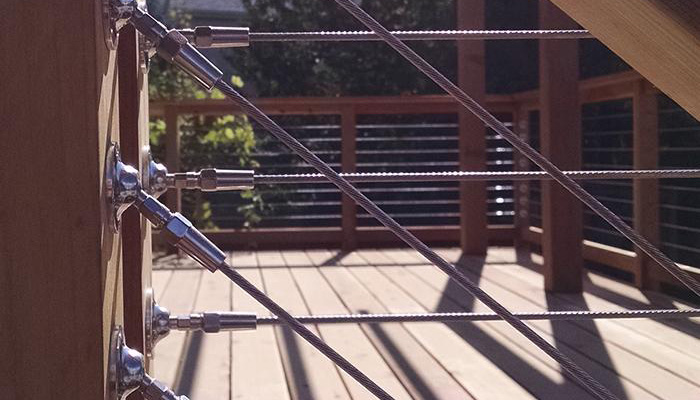Both swaged and swageless cable railing fittings provide a reliable connection between the cable and fitting. Indeed, both options can provide a link that equals or exceeds the breaking strength of the railing cable. So the question is swage vs. swageless.
However, there are minor differences between the two fitting styles that can impact the installation process and quality of the finish. Here’s what you need to know about swage vs swageless cable railing fittings.
What is Swaging?
Swaging is a method of securing cable railing wire with a permanently fitted cable or sleeve. The connection typically exceeds the rated breaking strength of the wire rope or cable. This is accomplished using fittings known as swages.
By definition, a swage fitting is a wire rope component. It is attached to the wire by compressing the fitting on the wire.
What Are The Differences Between Swage vs Swageless Railing Cable Systems?
A railing system secured with swage fittings is called a swaged system. Swaged systems have been around since cable railing systems were invented. Initially, railing cable installers hand-swaged the fittings using a variety of hand crimping tools and smaller swaging tools.
Hand crimpers (which look like bolt cutters) smash the swage fitting onto the cable with manual force, creating a seal. And it generally takes multiple crimps to achieve a proper connection.
Later, however, machine-swaged fittings were invented. These fittings are created in a shop by a fabricator using either a press swagger or a rolling swagger. The process cold-forms the fitting around the cable using much more force than hand crimpers can manage, resulting in a much stronger connection. This resulted in a more secure cable railing system.
As technology advanced even further, a new evolution of fittings known as swageless systems arrived. Swageless fittings don’t require any form of swaging or crimping. Instead, the fittings features a small one-way locking mechanism. This locking mechanism secures the railing system by allowing cables to enter in only one direction. It then grabs the cable if it is pulled in the opposite direction.

Pros and Cons of Swaged vs. Swageless Cable Railing Systems
Assuming that you’re using 1/8 inch or 5/32 inch diameter cables, both swage and swageless fittings can provide a solid and very reliable connection between the cable and fitting. However, they have varying pros and cons.
Pros and Cons of Swaged Fittings
Pros
- Swaged railing systems ensure a tight cable-to-frame fit, which creates a clean finish.
- Swaged fittings are generally less expensive than swageless fittings. For a large project, you can save a substantial amount.
Cons
- Swaging requires specialized equipment that most people, especially DIYers, may not have. Buying or renting the equipment can be expensive.
Pros and Cons of Swageless Fittings
Pros
- You can install Swageless cable railing fittings while installing the cable railing frames. Unlike with swage fittings, you do not have to wait for the exact measurements.
- No need for special equipment when installing Swageless fittings. This makes swageless fittings more convenient for DIY projects.
Cons
- The high cost is a major downside of swageless cable railing fittings. Swageless fittings are much more expensive than swaged options. Costs can quickly add up on a large project.
A Third Option; Pre-Swaging
If neither swage nor swageless fittings are suitable, a third option is available. You can have your fittings pre-swaged on both ends by a fabricator.
However, pre-swaging, too, has a few shortcomings. For one, you need to supply exact measurements to the fabricator to swage the fittings onto the cable. Additionally, the fittings come attached to the cable. Therefore, you must drill oversize holes during installation for them to pass through.
So, Which is the Best Option?
Swaged systems, such as Atlantis Rail’s RailEasy stainless steel cable railing system stand out among the options. These fittings are not only easy to work with but also extremely cost-effective.